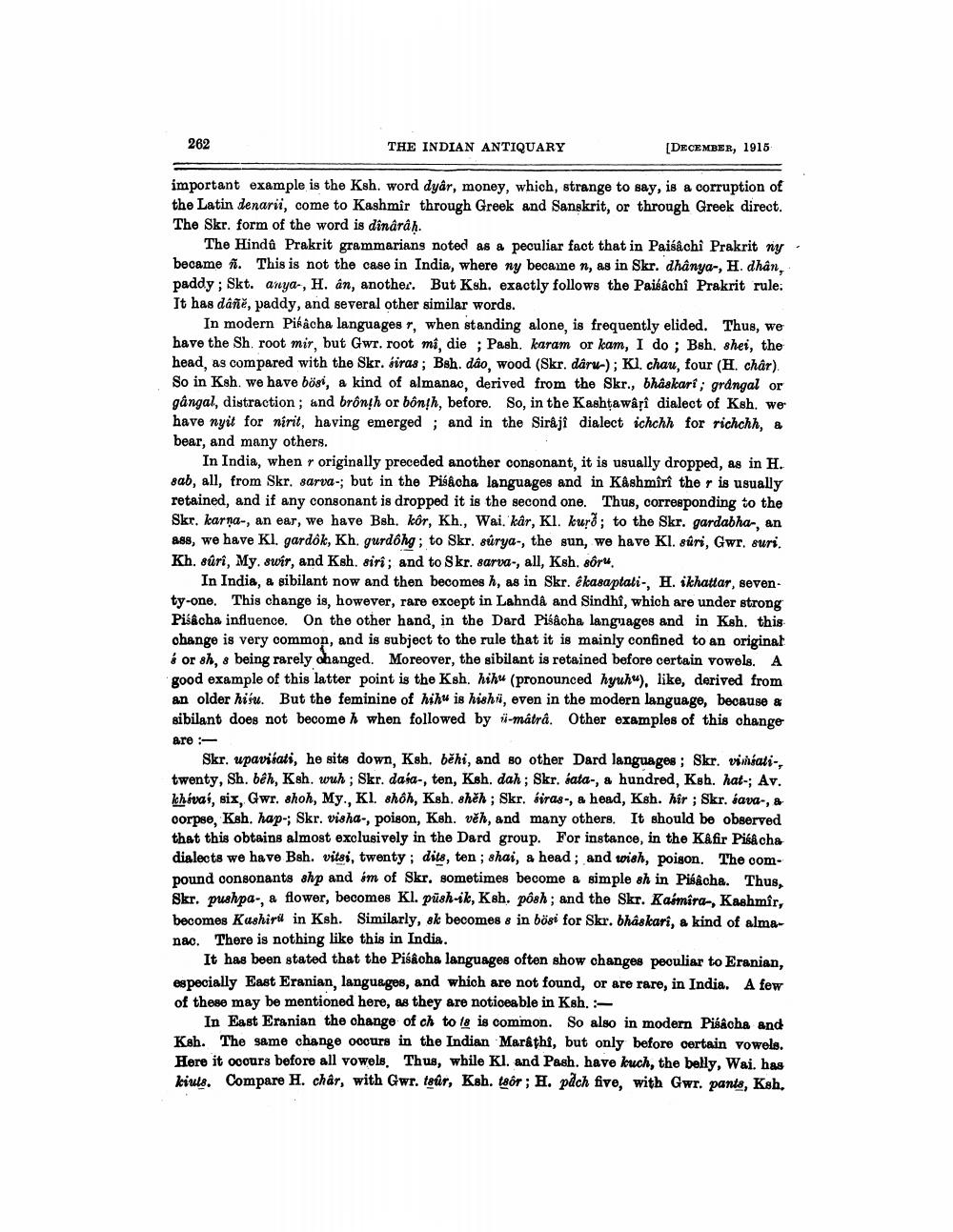________________
262
THE INDIAN ANTIQUARY
[DECEMBER, 1915
important example is the Ksh. word dyar, money, which, strange to say, is a corruption of the Latin denarii, come to Kashmir through Greek and Sanskrit, or through Greek direct. The Skr. form of the word is dinârâh.
The Hinda Prakrit grammarians noted as a peculiar fact that in Paisachi Prakrit ny became ñ. This is not the case in India, where ny became n, as in Skr. dhânya-, H. dhân, paddy ; Skt. anya-, H. an, another. But Ksh. exactly follows the Paisachi Prakrit rule: It has dañě, paddy, and several other similar words.
In modern Pikacha languages r, when standing alone, is frequently elided. Thus, we have the Sh. root mir, but Gwr.root mi, die ; Pash. karam or kam, I do ; Bsh, shei, the head, as compared with the Skr. siras; Bsh. dão, wood (Skr, daru-); Kl. chau, four (H. char) So in Ksh. we have bösi, a kind of almanac, derived from the Skr., bhaskari; grangal or gångal, distraction; and brôngh or bônļh, before. So, in the Kashtawâți dialect of Ksh. we have nyit for nirit, having emerged ; and in the Siraji dialect ichchh for richchh, & bear, and many others.
In India, when r originally preceded another consonant, it is usually dropped, as in H. sab, all, from Skr. sarva-; but in the Piskcha languages and in Kashmiri the r is usually retained, and if any consonant is dropped it is the second one. Thus, corresponding to the Skr, karna-, an ear, we have Bsh. kôr, Kh., Wai, kâr, Kl. kurð; to the Skr. gardabha-, an ass, we have Kl. gardók, Kh, gurdóhg; to Skr. súrya-, the sun, we have KI. sûri, Gwr, suri. Kh. suri, My, swir, and Ksh. siri; and to Skr. sarva-, all, Ksh. 8ôru.
In India, a sibilant now and then becomes h, as in Skr. ēkasaptati-, H. ikhattar, seventy-one. This change is, however, rare except in Lahndâ and Sindhi, which are under strong Pišâcha influence. On the other hand, in the Dard Pisacha languages and in Ksh. this change is very common, and is subject to the rule that it is mainly confined to an original á or sh, s being rarely changed. Moreover, the sibilant is retained before certain vowels. A good example of this latter point is the Ksh. hihu (pronounced hyuhu), like, derived from an older hiju. But the feminine of hihu is hishi, even in the modern language, because & sibilant does not become h when followed by 3-matra. Other examples of this change are :
Skr, upavitati, he site down, Ksh. běhi, and so other Dard languages; Skr. vinnsati-, twenty, Sh. bêh, Ksh. wuh ; Skr. daía-, ten, Ksh. dah ; Skr. data-, a hundred, Ksh. hat-; Av. Ichévas, six Gwr. shoh, My.. Kl. chôh, Ksh, sheh ; Skr. iras-, a head, Ksh. hir ; Skr. kava-, & oorpse, Ksh. hap-; Skr. visha-, poison, Ksh. věh, and many others. It should be observed that this obtains almost exclusively in the Dard group. For instance, in the Kafir Pisa cha dialects we have Bah. vitsi, twenty: dits, ten; ghai, a head; and wish, poison. The compound consonants shp and sm of Skr, sometimes become a simple sh in Pisacha. Thus, Skr. pushpa-, a flower, becomes Kl. pūsh-ik, Ksh. pôsh; and the Skr. Karmira-, Kashmir. becomes Kushiril in Ksh. Similarly, ak becomes 8 in bösi for Skr. bhaskari, a kind of almanac. There is nothing like this in India.
It has been stated that the Piskoha languages often show changes peculiar to Eranian, especially East Eranian, languages, and which are not found, or are rare, in India. A few of these may be mentioned here, as they are noticeable in Ksh.
In East Eranian the change of ch to 18 is common. So also in modern Piskoha and Ksh. The same change occurs in the Indian Marathi, but only before certain vowels. Here it ooours before all vowels. Thus, while Kl. and Pash. have kuch, the belly, Wai, has kiuls. Compare H. châr, with Gwr. tsûr, Ksh. tsôr ; H. pach five, with Gwr. pants, Ksh,




